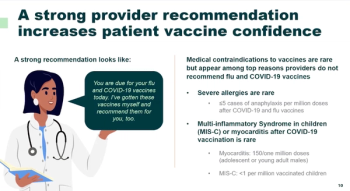
Flu vaccination rates decline as clinic days wear on
A new report highlights how flu vaccination rates decline as the day progresses, and how primary care practices can use ‘nudges’ to modify patient care behaviors.
A new study shows that some things-like providers reminding patients to get flu vaccinations-can fall through the cracks as the day wears on.
According to the report, vaccination rates were 44 percent from 8 a.m. until 10 a.m., declined to 41.2 percent by 11 a.m., 38.3 percent by noon, increased to 40.2 percent by 1 p.m., then declined again to 34.3 percent at 3 p.m. and 32 percent at 4 p.m.
During the study period, several practices were marked for interventions, including an active choice intervention in electronic health record (EHR) systems that provided a best practice alert when a patient was due for vaccination, as opposed to requiring a clinician to check and see if a patient was due.
During each year the study period, vaccination rates were 46.9 percent, 47.2 percent, and 45.6 percent, respectively, in control practices. Intervention practices reported rates of 49.7 percent, 52.2 percent, and 59.3 percent, respectively, with rates improving each year with intervention.
The study authors note that while the intervention helped to improve vaccination rates in some practices by nearly 20 percent from before intervention, these clinics still noted a decline in vaccination rates as the clinic day progressed.
“Our findings demonstrate the potential of using nudges in the EHR to improve vaccination rates,” the authors note.
The research team says the study highlights how practice workflow can impact vaccination rates and influence patient care.
One of the authors of the study, Mitesh Patel, MD, MBA, MS, assistant professor of medicine at the Perelman School of Medicine at the University of Pennsylvania and director of the Penn Medicine Nudge Unit, said well-designed nudges like the EHR intervention included in this study can help increase vaccination rates.
“There are several reasons why influenza vaccination rates are lower later in the day. Clinicians may face decision fatigue as the day goes on and later visits may be more rushed if they are running behind schedule. There may also be factors related to patients and practices that need to be better studied,” Patel said. “By recognizing these changes in influenza vaccination rates, future interventions could be better designed to address them. More practices could implement nudges to increase vaccination rates on a broader scale.”
The report suggests that further research should focus on what impacts medical decision-making behaviors as the day progresses, and how involving support staff, investigating workflow, and using best practice alerts could be factored in. The report notes that best practice alerts aren’t the only or best answer, as some clinicians in the study reported fatigue with the alerts and a level of confusion over whether physicians or support staff were responsible for addressing the alert.
Newsletter
Stay informed and empowered with Medical Economics enewsletter, delivering expert insights, financial strategies, practice management tips and technology trends — tailored for today’s physicians.








